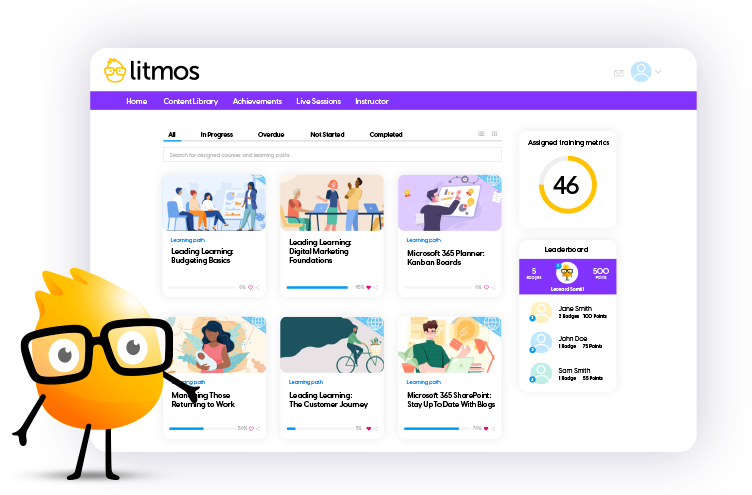Understanding the eLearning Content Process
Effective learning depends on well-designed content that’s delivered to the right student and the right time. While technology can simplify how content is created, packaged, shared, and measured, it’s no substitute for effective eLearning development.
The study of learning and instructional design isn’t new. By combining the lessons of traditional education, which was mostly focused on young learners, with the latest science on how adults learn, new standards emerged. With these foundational ideas in place, instructional authors and designers can create content that effectively communicates and maximize retention of the subject matter at hand.
What is the ADDIE framework?
The ADDIE framework was created at Florida State specifically for the US Army, although it was quickly adapted by all branches. Arguably the most important framework for adult learning, it was created in 1975 to specifically update traditional educational methods for the specific needs of adult learners.
ADDIE is designed as a continuous cycle that does the following:
Analysis of learning objectives, challenges, and constraints.
- This is where designers identify key learning goals and any limitations faced by learners as well as the project requirements that dictate timelines.
Design of overall coursework, content, and assessments
- This is where instructors begin to identify subject matter experts and other resources, as well as plan a mix of content, quizzes, and interactive elements that address outcomes and gaps identified in first phase.
Development of course content, from first draft through testing
- This is where the material is built by writers, designers, and programmers as required. It should end with testing on the desired platform.
Implementation of learning content and/or activity
- This is where users interact with the content and learning hopefully takes place. Whether it’s self-led and online or a traditional face-to-face instructional setting, it should end with measurement or assessment.
Evaluation of content and learner performance
- This is where instructional stakeholders review content and performance and look for gaps, always measuring versus goals established in first phase. Most importantly, it’s where adjustments are suggested, and improvements outlined.
Once this evaluation is done, the process loop should begin again until stakeholders are satisfied the course work is optimized and closely meets phase one objectives.
A newer approach: SAM
While the core tenets of ADDIE are still fundamental to professional instructional designers, there have been innovations on the process. A new approach, the Successive Approximate Model, creates even more iteration. By combining the ADDIE process with Agile software development best practices, instructors can more quickly develop high-quality learning experiences.
The key difference is that instead of waiting until after the course is delivered, evaluation occurs during the design and development phase. By repeating multiple iterative loops before implementation, a higher quality product is more achieved faster.
Practical Learning Design Goals
Beyond ADDIE and SAM, there are other frameworks emerging. Some of them are focused on specialized audiences, while others are specifically rooted in digital learning. Regardless of which standard you follow, the tenets of effective eLearning should be universal.
Engaging
Learning should get students involved. While this might seem like a tough challenge for dry or technical subject matter, it’s essential. It can’t always be entertaining, but it should be interesting, with as much video and interactivity as possible.
- Focus on the difference the knowledge will make
- Use real-world problem-solving exercises to ground ideas in the familiar
- Leverage humor whenever possible
Accessible
Content should be designed to for easy consumption and on-the-go learning on lots of different student devices, including smartphones. This means sharing ideas, no matter how complicated, in the simplest way possible. Students should never feel intimidated by big ideas.
- Break complicated concepts into smaller components
- Offer lots of recaps and reminders of what’s already been learned
- Use interactions and quizzes frequently to boost retention
Inclusive
Everybody learns at their own speed, according to their own strengths. Content should be designed to support the diversity of learners who will be consuming it.
- Ensure students understand prerequisites
- Teach with different modalities in the same content
- Avoid jargon wherever possible, opting for plain language instead
How to choose an ideal platform
While eLearning best practices are fundamental, so is choosing an LMS (learning management system) that can deliver on them. Identify the best solution that supports diverse learning styles and needs, robust content options, all driven by a unified platform that’s easy to use and administer.
Maximizing content creation options drives engagement, and the support for delivering to lots of different device types is key to creating accessible learning. Finally, offering different learning options ensures everybody can feel included in a culture of sustained learning and improvement.
Litmos LMS can help make good on the promises of cutting-edge adult learning by connecting best practices and even better technology. Simplified implementation, media-rich SCORM-compliant content, and integrated reporting help your training teams focus on what really matters.
Content for Specialized Audiences
That’s one reason leading organizations and brands all over the world turn to Litmos LMS. In addition to state-of-the-art functionality and a feature set that empowers the creation of unique learning content, Litmos also has content ready for specialized learners and audiences. These are high demand, high interest courses that cover the basics and beyond.
- Sales training
An educated sales team is your strongest advantage. While traditional sales training is disruptive and expensive, online eLearning with Litmos can reduce the cost while elevating quality. - Project management
This is one discipline that’s seen rapidly rising interest across nearly all industries. Litmos content can help learners acquire the skills they need to truly succeed. - Call management
Whether it’s sales, support, or customer service, call management is a specialized set of skills that’s increasingly in demand. These courses help the learner prepare for multiple roles.
Explore Litmos
It doesn’t matter what kind of training you’re planning—Litmos is the ideal platform. The easiest way to decide is through a 14-day trial that lets you explore all features and functions. The best part? It’s free, easy, and comes with no obligation.

Learn more:
What is a learning management system?


